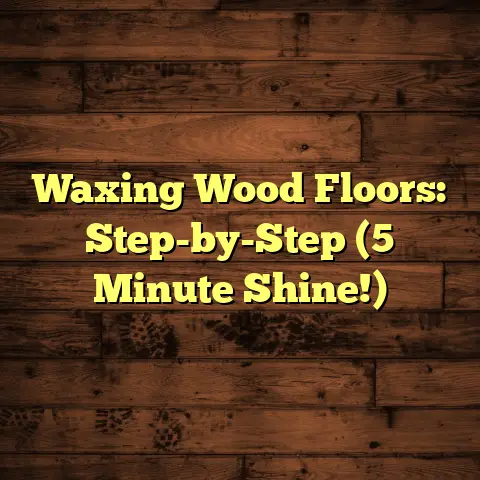Patching Concrete Floor Holes (3 Fixes to Know!)
Ever walk into a room and just know something’s off?
I remember one particularly gloomy Tuesday. Rain was hammering against the windows, and I got a call from a client frantic about a growing puddle in their living room.
Turns out, the carpet was hiding a nasty secret: a hole in the concrete slab. The water was seeping in, and the smell… damp and musty.
It was a homeowner’s worst nightmare, and honestly, as a flooring contractor, it’s a sight I’ve seen too often. The frustration, the worry about structural damage, the sheer ick factor – it’s all too real.
That day, patching that hole wasn’t just about fixing concrete; it was about restoring peace of mind. And that’s what I want to help you do today. Let’s dive into how to patch those pesky concrete floor holes and get your foundation back on solid ground (literally!).
Section 1: Understanding Concrete Floor Holes
So, what exactly are concrete floor holes? Simply put, they’re any unwanted openings in your concrete floor.
Think of them as concrete’s way of saying, “Hey, something’s not right!”
Common Culprits Behind the Holes:
-
Settling: Over time, the ground beneath your house can shift, causing the concrete to crack and eventually form holes. It’s like the earth is subtly rearranging itself, and your floor is caught in the middle.
-
Water Damage: Water is a relentless enemy of concrete. It seeps into cracks, freezes, expands, and boom, you’ve got bigger problems. Think of it like water turning into ice inside a bottle and cracking it.
-
Improper Installation: Sometimes, the concrete wasn’t mixed or poured correctly in the first place. This can lead to weak spots that crumble over time. It is like baking a cake with wrong ingredients.
-
Impact Damage: Dropping something heavy or dragging something across the floor can cause chipping and eventually holes. Imagine dropping a bowling ball on your toe, it is going to hurt, right?
Why You Can’t Ignore Them:
Leaving these holes unaddressed is a recipe for disaster. Here’s why:
-
Safety Hazards: A hole can be a serious tripping hazard, especially for kids or the elderly. Imagine someone tripping and falling, ouch!
-
Aesthetic Issues: Let’s face it, holes in your floor are just plain ugly. They detract from the overall look of your home.
-
Structural Damage: If water gets into the holes, it can erode the concrete and even damage the foundation of your house. This can lead to costly repairs down the road.
-
Pest Infestation: Holes can become homes for insects and rodents. Nobody wants unwanted guests!
Types of Concrete Floors and Their Vulnerabilities:
Not all concrete floors are created equal. Here’s a quick rundown:
-
Polished Concrete: Sleek and modern, but susceptible to scratches and chips if not properly sealed.
-
Stained Concrete: Beautiful color, but the stain can fade or become uneven if the underlying concrete is damaged.
-
Stamped Concrete: Decorative patterns, but the edges of the stamps can chip or crack.
-
Sealed Concrete: A protective layer against moisture and stains, but the sealant can wear away over time, leaving the concrete exposed.
No matter what type of concrete floor you have, those holes are a problem waiting to happen.
Section 2: The Importance of Prompt Repair
Why is it so crucial to tackle those concrete floor holes ASAP? Think of it this way: a small crack is like a minor cut. You clean it, put on a bandage, and it heals. But if you ignore it, it can get infected and become a much bigger issue.
The same principle applies to concrete.
Domino Effect of Neglect:
-
Small Crack Becomes a Big Crack: Water seeps in, freezes, expands, and suddenly that tiny hairline crack is a gaping chasm.
-
Water Damage Escalates: Moisture can lead to mold and mildew growth, which can cause health problems and further damage the concrete. I’ve seen cases where mold growth necessitated complete floor replacement!
-
Structural Integrity Compromised: If the damage extends to the foundation, you’re looking at serious structural problems that can be incredibly expensive to fix. Imagine the cost of underpinning a house versus patching a small hole!
The Upsides of a Proactive Approach:
-
Saves You Money: Addressing the problem early prevents it from escalating into a major repair. A few dollars worth of patching compound can save you thousands in foundation repairs.
-
Maintains Your Home’s Value: A well- maintained home is a valuable home. Fixing those concrete floor holes shows that you care about your property.
-
Enhances Safety: Eliminating tripping hazards makes your home safer for everyone.
-
Boosts Aesthetics: A smooth, unblemished concrete floor looks great and adds to the overall appeal of your home.
-
Peace of Mind: Knowing that your foundation is solid and secure gives you peace of mind. And that’s priceless.
Real-World Example:
I once had a client who ignored a small crack in their garage floor for years. Eventually, water seeped in, corroded the rebar (the steel reinforcing bars inside the concrete), and caused a large section of the floor to collapse.
The repair cost them over $10,000! If they had addressed the crack early on, they could have saved themselves a lot of money and hassle.
Don’t let that happen to you!
Section 3: Fix #1 – Using Concrete Patch Compound
Alright, let’s get our hands dirty! The first (and often easiest) fix for small to medium-sized holes in your concrete floor is using a concrete patch compound.
Think of it as spackle for your concrete.
What You’ll Need:
-
Concrete Patch Compound: Choose a product specifically designed for concrete floor repairs.
-
Wire Brush: For cleaning the area.
-
Shop Vacuum: To remove dust and debris.
-
Trowel or Putty Knife: For applying the patch compound.
-
Mixing Bucket and Stir Stick: If the patch compound requires mixing.
-
Water: For mixing (if needed).
-
Safety Glasses and Gloves: Always protect yourself!
Step-by-Step Guide:
-
Prepare the Area: This is crucial. Use the wire brush to thoroughly clean the area around the hole, removing any loose debris, dirt, or old concrete. Then, vacuum up all the dust. You want a clean, stable surface for the patch to adhere to.
-
Mix the Patch Compound: Follow the manufacturer’s instructions exactly. Most compounds require mixing with water. Add the water slowly, stirring constantly, until you achieve a smooth, workable consistency. Think of it like making pancake batter – you want it thick enough to spread but not so thick that it’s lumpy.
-
Dampen the Hole: Lightly dampen the inside of the hole with water. This helps the patch compound bond to the existing concrete. Don’t soak it, just a light mist will do.
-
Apply the Patch Compound: Using the trowel or putty knife, apply the patch compound to the hole, pressing it firmly into place. Overfill the hole slightly, as the compound will shrink as it dries.
-
Smooth and Finish: Use the trowel or putty knife to smooth the surface of the patch, blending it seamlessly with the surrounding concrete. You can use a damp sponge to create a smooth, even finish.
-
Cure the Patch: Follow the manufacturer’s instructions for curing. This usually involves keeping the patched area damp for a certain period of time. You can cover it with plastic sheeting to retain moisture.
Choosing the Right Product:
-
Size of the Hole: For small holes (less than 1/4 inch deep), a pre-mixed patch compound is usually sufficient. For larger holes, you may need a more heavy-duty compound.
-
Type of Concrete Floor: Some patch compounds are specifically designed for certain types of concrete, such as polished or stained concrete. Read the label carefully to make sure you’re choosing the right product.
-
Location: If the hole is in a high- traffic area, you’ll want a patch compound that is durable and resistant to wear and tear.
Drying Times and Finishing Touches:
Drying times vary depending on the product you use and the ambient temperature and humidity. Always follow the manufacturer’s instructions.
Once the patch is fully cured, you can sand it lightly to create an even smoother finish. If you have stained concrete, you may need to apply a matching stain to the patched area to blend it in.
Pro Tip: For a really seamless look, consider using a concrete grinder to feather the edges of the patch into the surrounding concrete.
Section 4: Fix #2 – Epoxy Injection
For more substantial cracks or holes, especially those that might be affecting the structural integrity of your floor, epoxy injection is the way to go.
Think of it as concrete surgery.
What is Epoxy and Why Use It?
Epoxy is a two-part resin that, when mixed, creates a super-strong, durable adhesive. It’s incredibly effective at filling cracks and bonding concrete together.
Why Epoxy Injection?
-
Structural Repair: Epoxy can restore the structural integrity of cracked concrete.
-
Waterproofing: Epoxy creates a water-tight seal, preventing further damage from moisture.
-
Long-Lasting: Epoxy repairs are incredibly durable and can last for many years.
What You’ll Need:
-
Epoxy Injection Kit: These kits typically include the epoxy resin, hardener, injection ports, and a caulking gun.
-
Surface Cleaner: To remove dirt and grease from the concrete.
-
Wire Brush: For cleaning the cracks.
-
Shop Vacuum: To remove dust and debris.
-
Caulking Gun: For injecting the epoxy.
-
Putty Knife: For applying the epoxy.
-
Safety Glasses and Gloves: Epoxy can be irritating to the skin and eyes, so protection is essential.
The Epoxy Injection Process:
-
Prepare the Crack: Use the wire brush to thoroughly clean the crack, removing any loose debris, dirt, or old concrete. Then, vacuum up all the dust.
-
Install Injection Ports: These are small plastic nozzles that you’ll use to inject the epoxy. Place them along the crack, spacing them a few inches apart. You can use epoxy paste to adhere them to the concrete.
-
Seal the Surface: Use epoxy paste to seal the surface of the crack between the injection ports. This prevents the epoxy from leaking out during the injection process.
-
Mix the Epoxy: Follow the manufacturer’s instructions exactly. Mix the epoxy resin and hardener thoroughly.
-
Inject the Epoxy: Load the mixed epoxy into the caulking gun and inject it into the injection ports, starting at the lowest port and working your way up. Continue injecting until the epoxy starts to flow out of the adjacent port.
-
Remove Excess Epoxy: Once the epoxy has cured (follow the manufacturer’s instructions for curing time), use a putty knife to remove any excess epoxy from the surface of the concrete.
Safety Precautions:
-
Ventilation: Work in a well- ventilated area, as epoxy fumes can be irritating.
-
Skin and Eye Protection: Always wear safety glasses and gloves when working with epoxy.
-
Read the Instructions: Follow the manufacturer’s instructions exactly.
Smoothing the Surface:
Once the epoxy has cured and you’ve removed the excess, you can sand the surface lightly to create a smooth, even finish. If necessary, you can apply a concrete patch compound to fill any remaining imperfections.
Pro Tip: For deep cracks, you may need to inject the epoxy in multiple stages, allowing each layer to cure before applying the next.
Section 5: Fix #3 – Using Concrete Resurfacer
When you’re dealing with a concrete floor that’s riddled with numerous small holes, cracks, and imperfections, or when you want to give your entire floor a fresh, new look, concrete resurfacer is your best bet.
Think of it as giving your floor a brand-new skin.
What is Concrete Resurfacer?
Concrete resurfacer is a cement-based product that’s designed to be applied over existing concrete, creating a smooth, durable, and attractive surface. It’s like a thin layer of new concrete that bonds to the old concrete.
When to Use Concrete Resurfacer:
-
Numerous Small Holes and Cracks: If your floor has too many small imperfections to patch individually, resurfacing is a more efficient solution.
-
Worn or Damaged Surface: If your concrete floor is simply worn down or damaged, resurfacing can restore its appearance and functionality.
-
Decorative Upgrade: Concrete resurfacer can be used to create a variety of decorative finishes, such as stamped patterns, textures, or colors.
What You’ll Need:
-
Concrete Resurfacer: Choose a product specifically designed for your needs.
-
Concrete Cleaner: To remove dirt, grease, and stains from the existing concrete.
-
Pressure Washer: For cleaning the concrete.
-
Mixing Bucket and Drill with Mixing Paddle: For mixing the resurfacer.
-
Squeegee or Trowel: For applying the resurfacer.
-
Spiked Roller: To remove air bubbles.
-
Safety Glasses and Gloves: Always protect yourself!
Step-by-Step Guide:
-
Prepare the Concrete: This is critical. Use the concrete cleaner and pressure washer to thoroughly clean the existing concrete, removing any dirt, grease, stains, or loose debris. The concrete needs to be clean and porous for the resurfacer to bond properly.
-
Etch the Concrete (Optional): For optimal adhesion, you may need to etch the concrete with a concrete etching solution. This opens up the pores of the concrete, allowing the resurfacer to bond more effectively. Follow the manufacturer’s instructions for etching.
-
Mix the Concrete Resurfacer: Follow the manufacturer’s instructions exactly. Add water slowly, mixing with the drill and mixing paddle, until you achieve a smooth, pourable consistency.
-
Apply the Resurfacer: Pour the mixed resurfacer onto the concrete floor and spread it evenly with the squeegee or trowel. Work in small sections to ensure even coverage.
-
Remove Air Bubbles: Use the spiked roller to remove any air bubbles from the resurfacer. This will create a smoother, more durable finish.
-
Cure the Resurfacer: Follow the manufacturer’s instructions for curing. This usually involves keeping the resurfaced area damp for a certain period of time. You can cover it with plastic sheeting to retain moisture.
Decorative Finishes:
Once the resurfacer is applied, you can add a variety of decorative finishes, such as:
-
Stamping: Use concrete stamps to create patterns and textures.
-
Staining: Apply a concrete stain to add color.
-
Scoring: Cut lines into the resurfacer to create a tile-like effect.
Maintenance Tips:
To keep your resurfaced concrete floor looking its best, follow these maintenance tips:
-
Seal the Surface: Apply a concrete sealer to protect the resurfacer from stains and moisture.
-
Clean Regularly: Sweep or vacuum the floor regularly to remove dirt and debris.
-
Avoid Harsh Chemicals: Don’t use harsh chemicals or abrasive cleaners, as they can damage the resurfacer.
Pro Tip: Before applying the resurfacer, consider using a self- leveling underlayment to create a perfectly smooth and level surface.
Section 6: Conclusion
We’ve covered a lot of ground (pun intended!) today. We’ve explored three effective methods for patching concrete floor holes:
-
Concrete Patch Compound: Ideal for small to medium-sized holes.
-
Epoxy Injection: Best for structural repairs and waterproofing.
-
Concrete Resurfacer: Perfect for covering numerous imperfections and giving your floor a fresh, new look.
Remember that gloomy Tuesday I mentioned at the beginning? The relief on my client’s face when we patched that hole and stopped the water from seeping in was palpable. It wasn’t just about fixing a floor; it was about restoring their peace of mind.
And that’s what I hope this article has done for you. Whether you’re dealing with a minor crack or a more significant hole, don’t let it linger. Take action, choose the right method, and get your concrete floor back in tip-top shape.
With the right knowledge and tools, you can successfully tackle these repairs. And the satisfaction of a job well done, a safe and beautiful floor, is well worth the effort.
So, go forth and conquer those concrete floor holes! Your foundation will thank you for it.





